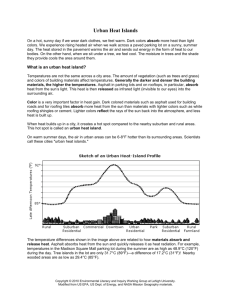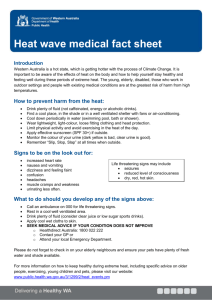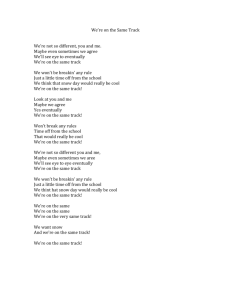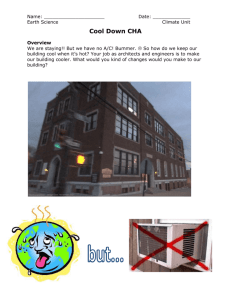Exploring the Lehigh Valley Area - Lehigh University Environmental
advertisement
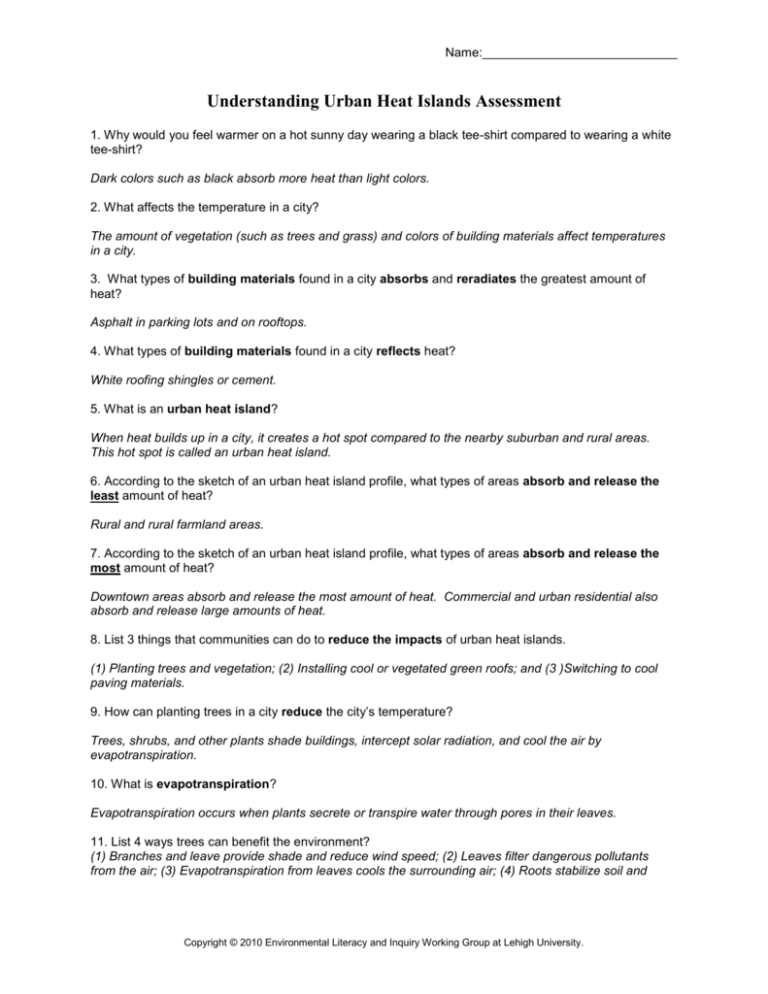
Name:____________________________ Understanding Urban Heat Islands Assessment 1. Why would you feel warmer on a hot sunny day wearing a black tee-shirt compared to wearing a white tee-shirt? Dark colors such as black absorb more heat than light colors. 2. What affects the temperature in a city? The amount of vegetation (such as trees and grass) and colors of building materials affect temperatures in a city. 3. What types of building materials found in a city absorbs and reradiates the greatest amount of heat? Asphalt in parking lots and on rooftops. 4. What types of building materials found in a city reflects heat? White roofing shingles or cement. 5. What is an urban heat island? When heat builds up in a city, it creates a hot spot compared to the nearby suburban and rural areas. This hot spot is called an urban heat island. 6. According to the sketch of an urban heat island profile, what types of areas absorb and release the least amount of heat? Rural and rural farmland areas. 7. According to the sketch of an urban heat island profile, what types of areas absorb and release the most amount of heat? Downtown areas absorb and release the most amount of heat. Commercial and urban residential also absorb and release large amounts of heat. 8. List 3 things that communities can do to reduce the impacts of urban heat islands. (1) Planting trees and vegetation; (2) Installing cool or vegetated green roofs; and (3 )Switching to cool paving materials. 9. How can planting trees in a city reduce the city’s temperature? Trees, shrubs, and other plants shade buildings, intercept solar radiation, and cool the air by evapotranspiration. 10. What is evapotranspiration? Evapotranspiration occurs when plants secrete or transpire water through pores in their leaves. 11. List 4 ways trees can benefit the environment? (1) Branches and leave provide shade and reduce wind speed; (2) Leaves filter dangerous pollutants from the air; (3) Evapotranspiration from leaves cools the surrounding air; (4) Roots stabilize soil and Copyright © 2010 Environmental Literacy and Inquiry Working Group at Lehigh University. 2 prevent erosion; (5) Roots, leaves, and trunks provide habitat for animals; (6) Leaves and branches absorb sound and block erosion causing rainfall. 12. What is a cool roof? How does a cool roof keep material cooler and help reduce the heat island effect? The term "cool roof" is used to describe roofing material that has high solar reflectance. These materials reflect a large portion of the sun's energy. Cool roofs also may have a high thermal emittance and release a large percentage of absorbed heat. This keeps the material cooler and helps to reduce the heat island effect. 13. What are cool paving materials and how can they reduce a city’s temperature? Cool paving materials reduce the absorption of solar heat and later transfer of this heat to the surroundings. Lighter-colored paving materials come in shades of white, beige, light gray and terra cotta. Permeable pavements can be constructed from a number of materials including concrete and asphalt, filled with soil, gravel, and grass. Cool paving materials reduce the absorption of solar heat and later transfer of this heat to the surroundings. 14. Why is using a light-colored paved area for a city plaza a better choice than a dark, colored asphalt paved area? Lighter-colored materials have higher solar reflectance, so they absorb less of the sun's energy and stay cooler. 15. How do porous (or permeable) pavements reduce heat? Porous (or permeable) pavements allow water to filter into the ground, keeping the pavement cool when moist. 16. Imagine you were given 10 million dollars to reduce the heat island effect in your city. What would you do to most effectively reduce the city’s temperature? Answers will vary. A combination of strategies that include (1) Planting trees and vegetation; (2) Installing cool or vegetated green roofs; and (3) Switching to cool paving materials would be a highly effective strategy. Copyright © 2010 Environmental Literacy and Inquiry Working Group at Lehigh University.
